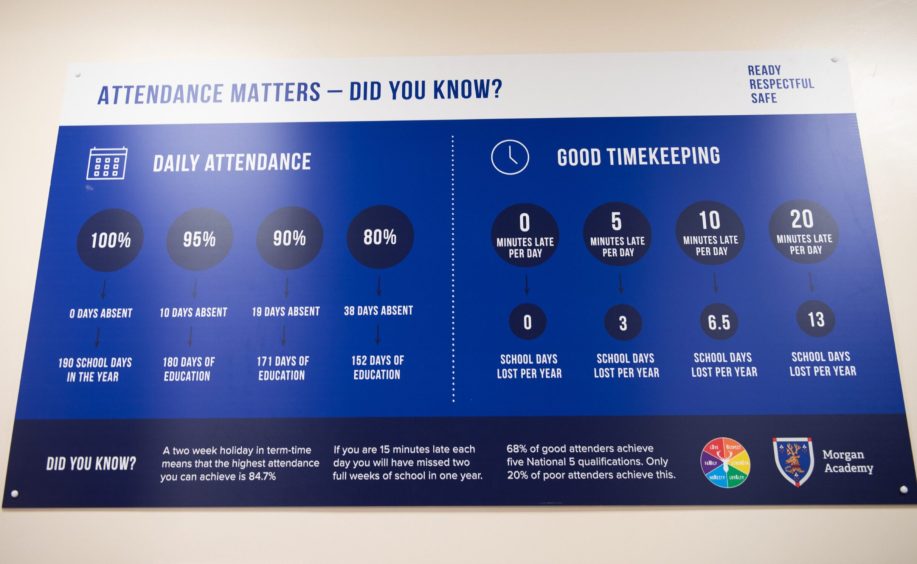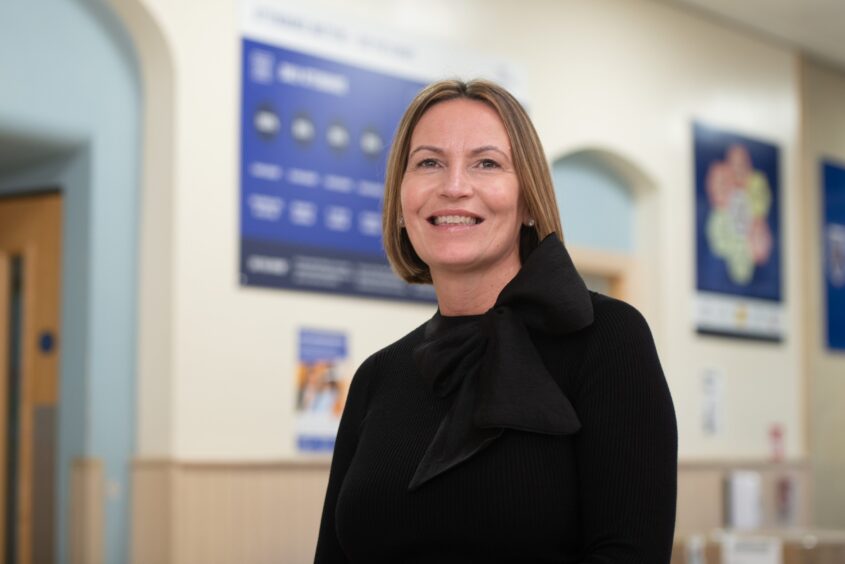
James, 14, rarely went to school.
Lonely and angry, he had fallen out with his mum and his friends and spent most of time in his bedroom feeling no one listened to him.
On average, he was in school one day a week.
Rachel, 13, looked tired and pale on the two or three days she would attend each week. She was often late and would sometimes leave at lunchtime.
She suffers from anxiety and her mum, for whom English is a second language, works long hours.
But both Morgan Academy pupils – whose names and ages we have changed to protect their identity – are now in school much more often, thanks to an initiative at the Dundee secondary to tackle poor attendance.
During 2021/22, 384 secondary pupils in the city missed half or more of their schooling, according to a freedom of information response provided by Dundee City Council.
Recognising a strong link between absence and attainment, Morgan Academy launched a project to try to boost attendance, particularly among those from deprived backgrounds.
Head teacher Johnny Lothian explained: “We were seeing our attendance levels hovering around 86 to 88% which, although it doesn’t always work out that way, is one full day of absence every fortnight.
“For some young people it’s much more significant than that and we know that’s having an impact on their learning.
“We know that young people whose attendance is dropping in second and third year tend to have poorer educational outcomes by the time they reach the end of fourth year.
“These are young people who often are not staying on for fifth and sixth year and we know at Morgan that if young people do stay on for fifth and sixth year their educational outcomes are good.
Three ways of ‘supercharging’ attendance
“We also know there’s a strong correlation between attendance rates and levels of disadvantage.”
The attendance gap between the most and least disadvantaged households was, he said, 5% to 6%.
The school took a three-pronged approach to tackle this issue, looking at the school’s culture, systems and staffing.
Mr Lothian said: “Our approach was ‘how can we improve our attendance overall?’ It was also ‘how can we almost supercharge the attendance of that group of young people?’
“Thirdly ‘how do we demonstrate improvement?’”
It looked at how the value of good attendance was being promoted to children and families, how it was recording and intervening in attendance matters and staffing.
Listening to pupils, Mr Lothian said, was key.
“The reasons for non-attendance are complex and multifarious,” he said, “there’s not one answer.
“Young people talked about routines, particularly in the morning, and breakfast was part of that.
“Another thing that came out was quite high levels of poverty.”
So the school introduced a breakfast club which is open to all pupils.
The work of a financial inclusion officer already in post was brought into alignment with the strategy.
A campaign was launched to promote good attendance. An infographic just inside the school entrance shows pupils how much lost school time can affect their learning.
Finally and crucially, the school appointed a pupil support officer to work with a group of 17 pupils identified as most in need of support.
For James and Rachel, their contact with attendance and family engagement officer Lesley Bollan has been transformational.
When James was absent Lesley would call home and encourage him to come in – sometimes successfully, sometimes not. When he did come, she welcomed and praised him.
If he was off for a long time, she would meet up with him, perhaps for a walk in the park, to ensure he was ok and knew the school cared about him.
Weekly one-to-one meetings gave him the chance to share his thoughts and feelings and be heard.
And he was introduced to the school’s Chill Zone where he made new friends.
His attendance has risen from 18% to 57%.
When Rachel was absent for more than three days, Lesley would go to her home.
Letters were translated for her mum and a translator brought into meetings.
Online resources were identified to help Rachel manage her anxiety, and support sourced for her mum.
When Rachel went to school she was praised and rewarded with Morgan’s Friday donut of success, a tradition for recognising pupils’ achievement.
Her health and wellbeing has improved and her attendance has soared from 47% to 92%.
Morgan Academy absence has declined
During the 18 months the school piloted this work its attendance rate rose by 1.5%, at a time when most schools saw attendance decline or remain static.
Twelve out of the 17 young people targeted are now in school more often. Some have ‘graduated’ from the scheme and their places have been taken by others.
There’s still work to be done, admits Mr Lothian.
But he said: “We are responsive when there are issues and are trying to really understand what is going to make a difference for these young people and their families.”
Under Dundee City Council’s Every Dundee Learner Matters strategy, every school and nursery must have what is known as a school inquiry group (SIG) to look at how barriers can be overcome, and absence was the focus of Morgan Academy’s.
The strategy – which aims to foster equity in education – is supported by researchers from the Robert Owen Centre for Educational Change at the University of Glasgow
Dundee’s chief education officer Paul Fleming said lessons learned by SIGs are shared among head teachers, so they can be adapted and used in their own schools.
Lessons learned from Morgan are already being used to recruit a financial support officer for families in the Craigie High School and Braeview Academy areas.
Mr Fleming said: “We see Every Dundee Learner Matters as our overarching improvement strategy.
“We do well for lots of learners but we ask ‘who is it we are not doing so well for and what are we going to do about it?’”













Conversation